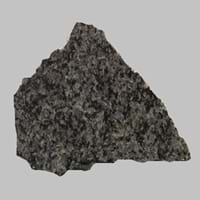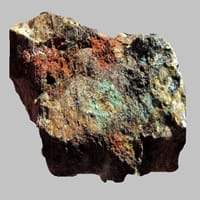Definition
Norite is a mafic intrusive igneous rock composed largely of the calcium-rich plagioclase labradorite, orthopyroxene, and olivine
Jasperoid is a rare, peculiar type of metasomatic alteration of rocks
Discoverer
Unknown
Unknown
Etymology
From the Norwegian name for Norway, Norge
From silica, the main mineral content of Jasperoid
Class
Igneous Rocks
Sedimentary Rocks
Sub-Class
Durable Rock, Hard Rock
Durable Rock, Medium Hardness Rock
Group
Plutonic
Not Applicable
Other Categories
Coarse Grained Rock, Opaque Rock
Coarse Grained Rock, Fine Grained Rock, Medium Grained Rock, Opaque Rock
Texture
Phaneritic
Earthy
Color
Dark Grey to Black
Black, Brown, Colourless, Green, Grey, Pink, White
Durability
Durable
Durable
Scratch Resistant
Yes
Yes
Appearance
Veined and Shiny
Glassy or Pearly
Interior Uses
Decorative Aggregates, Entryways, Interior Decoration
Decorative Aggregates, Floor Tiles, Homes, Interior Decoration
Exterior Uses
As Building Stone, As Facing Stone, Paving Stone, Garden Decoration
As Building Stone, Garden Decoration, Office Buildings, Paving Stone
Other Architectural Uses
Curbing
Curbing
Construction Industry
As Dimension Stone, Building houses or walls, Cement Manufacture, Construction Aggregate, for Road Aggregate
As a Flux in the Production of Steel and Pig Iron, As a Sintering Agent in Steel Industry to process Iron Ore, As Dimension Stone, Cement Manufacture, for Road Aggregate, Making natural cement, Manufacture of Magnesium and Dolomite Refractories, Production of Glass and Ceramics, Serves as an Oil and Gas Reservoir rock
Medical Industry
Not Yet Used
Taken as a Supplement for Calcium or Magnesium
Antiquity Uses
Artifacts, Monuments, Sculpture
Artifacts, Jewellery, Monuments, Sculpture
Commercial Uses
Cemetery Markers, Commemorative Tablets, Laboratory bench tops, Jewelry, Sea Defence, Tombstones
An Oil and Gas Reservoir, As a Feed Additive for Livestock, Gemstone, Metallurgical Flux, Production of Lime, Soil Conditioner, Source of Magnesia (MgO)
Types
Not Available
Not Available
Features
Smooth to touch
Host Rock for Lead, Traps for subsurface fluids like Oil and Natural Gas., Zinc and Copper Deposits
Archaeological Significance
Famous Monuments
Data Not Available
Data Not Available
Famous Sculptures
Data Not Available
Data Not Available
Pictographs
Not Used
Used
Petroglyphs
Not Used
Used
Formation
Norite is a fine-grained, hard rock which is a type of metasomatite, essentially altered basalt. It forms with or without crystallization, either below the surface as intrusive rocks or on the surface as extrusive rocks.
Jasperoid is a rare and peculiar type of metasomatic alteration of rocks. It is formed by extreme alteration of wall rocks within a shear zone which may occur in sediments, andesites, trachytes and basalts.
Mineral Content
Augite, Olivine, Plagioclase, Pyroxene
Clay Minerals, Pyrite, Quartz, Sulfides
Compound Content
Aluminium Oxide, CaO, Chromium(III) Oxide, Iron(III) Oxide, Potassium Oxide, MgO, Sodium Oxide, Silicon Dioxide, Sulfur Trioxide
NaCl, CaO, Carbon Dioxide, Magnesium Carbonate, MgO
Types of Metamorphism
Cataclastic Metamorphism, Impact Metamorphism
Burial Metamorphism, Cataclastic Metamorphism, Regional Metamorphism
Types of Weathering
Biological Weathering
Not Applicable
Types of Erosion
Chemical Erosion, Coastal Erosion
Not Applicable
Grain Size
Coarse Grained
Medium to Fine Coarse Grained
Fracture
Conchoidal
Conchoidal
Porosity
Highly Porous
Less Porous
Luster
Not Available
Vitreous and Pearly
Cleavage
Not Available
Perfect
Specific Gravity
2.86-2.87
2.8-3
Transparency
Opaque
Transparent to Translucent
Density
2.7-3.3 g/cm3
2.8-2.9 g/cm3
Specific Heat Capacity
Not Available
Resistance
Impact Resistant, Pressure Resistant, Wear Resistant
Heat Resistant, Pressure Resistant, Wear Resistant
Deposits in Eastern Continents
Asia
India, Russia
China, India
Africa
South Africa
Morocco, Namibia
Europe
Germany, Greece, Italy, Scotland, Turkey
Austria, Italy, Romania, Spain, Switzerland
Others
Greenland
Not Yet Found
Deposits in Western Continents
North America
Canada, USA
Mexico, USA
South America
Brazil, Colombia, Venezuela
Brazil, Colombia
Deposits in Oceania Continent
Australia
New Zealand, Queensland
New South Wales, Queensland, Yorke Peninsula
Norite vs Jasperoid Characteristics
Though some rocks look identical, they have certain characteristics which distinguish them from others. Characteristics of rocks include texture, appearance, color, fracture, streak, hardness etc. Norite vs Jasperoid characteristics assist us to distinguish and recognize rocks. Also you can check about Properties of Norite and Properties of Jasperoid. Learn more about Norite vs Jasperoid in the next section. The interior uses of Norite include Decorative aggregates, Entryways and Interior decoration whereas the interior uses of Jasperoid include Decorative aggregates, Floor tiles, Homes and Interior decoration. Due to some exceptional properties of Norite and Jasperoid, they have various applications in construction industry. The uses of Norite in construction industry include As dimension stone, Building houses or walls, Cement manufacture, Construction aggregate, For road aggregate and that of Jasperoid include As a flux in the production of steel and pig iron, As a sintering agent in steel industry to process iron ore, As dimension stone, Cement manufacture, For road aggregate, Making natural cement, Manufacture of magnesium and dolomite refractories, Production of glass and ceramics, Serves as an oil and gas reservoir rock.
More about Norite and Jasperoid
Here you can know more about Norite and Jasperoid. The life cycle of a rock consists of formation of rock, composition of rock and transformation of rock. The composition of Norite and Jasperoid consists of mineral content and compound content. The mineral content of Norite includes Augite, Olivine, Plagioclase, Pyroxene and mineral content of Jasperoid includes Clay Minerals, Pyrite, Quartz, Sulfides. You can also check out the list of all Igneous Rocks. When we have to compare Norite vs Jasperoid, the texture, color and appearance plays an important role in determining the type of rock. Norite is available in dark grey to black colors whereas, Jasperoid is available in black, brown, colourless, green, grey, pink, white colors. Appearance of Norite is Veined and Shiny and that of Jasperoid is Glassy or Pearly. Properties of rock is another aspect for Norite vs Jasperoid. The hardness of Norite is 7 and that of Jasperoid is 3.5-4. The types of Norite are Not Available whereas types of Jasperoid are Not Available. Streak of rock is the color of powder produced when it is dragged across an unweathered surface. The streak of Norite is black while that of Jasperoid is white. The specific heat capacity of Norite is Not Available and that of Jasperoid is 0.92 kJ/Kg K. Depending on the properties like hardness, toughness, specific heat capacity, porosity etc., rocks are resistant to heat, wear, impact, etc.Norite is impact resistant, pressure resistant, wear resistant whereas Jasperoid is heat resistant, pressure resistant, wear resistant.





